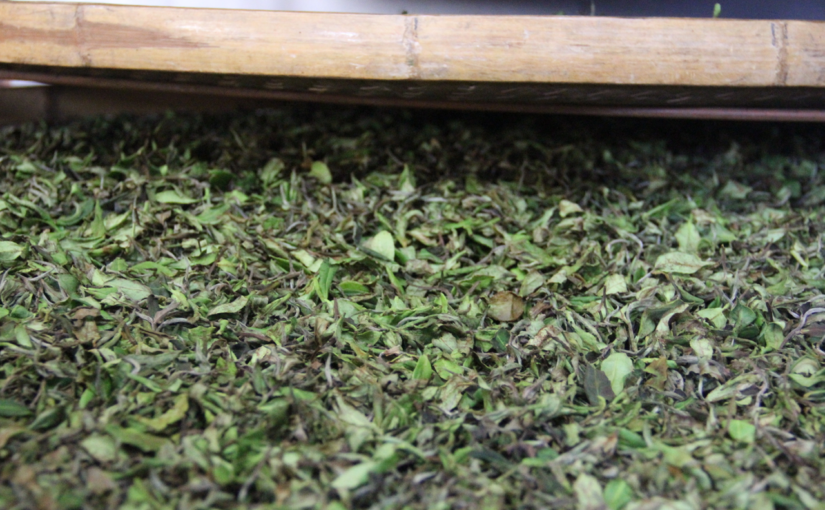Part of earning “geek status” in the tea world is learning a bit of the specialized jargon that goes along with it. As in any specialized field of industry or study, jargon can be problematic, especially when that jargon takes the form of using words that already exist in everyday English and applying new meaning to them. Perhaps the most frustrating example of this is the word “theory†which in everyday English means “a guessâ€, but in science means essentially the exact opposite—“a broad explanation of something that we’re really certain aboutâ€. The lexicon surrounding tea is no less confusing. In this series, I’m going to explore the jargon behind two different processes important for tea production that are both sometimes called “fermentation.†I’m also going to dive into the biology and chemistry behind steps of tea processing and suggest some new terms that could make the biology and chemistry even clearer.
In part one, I’m going to be tackling the problem of what to call the processing step that makes green tea leaves into black tea. In the tea industry, this is often called “fermentation†which is a direct translation of the Chinese fÄjià o. This is the process that makes green tea leaves darken in color to produce oolong or black tea.
What’s going on:
Almost all plant parts contain a suite of chemicals called catechins, one group of a larger family of compounds called polyphenols. They all share a similar structure that includes several alcohol (-OH) group sticking off of them. Catechins are colorless and have a variety of functions in plants including acting as antioxidants to snatch up DNA damaging free-radicals. They are generally kept in a compartment called a vacuole inside the plant cell. Plant cells also contain an enzyme called polyphenol oxidase. Like all enzymes, polyphenol oxidase is a large (relative to the catechins), protein machine designed to speed along a specific chemical reaction. Polyphenol oxidase is kept in a separate compartment from catechins, called a plastid, and it can only do its particular job when a plant cell is damaged, like when tea leaves are bruised during the production of oolong or black tea.

When the leaf is damaged, polyphenol oxidase mixes with the catechins and speeds along a reaction converting catechins into quinones by removing the hydrogen atoms (H) and some electrons from those alcohol groups (-OH) with the help of oxygen from the air (Oâ‚‚). Quinones are then able to bind with other quinones or other polyphenols forming larger, more complex polyphenols that tend to have a reddish brown color.
However, if you apply heat early on in tea processing, the enzymes (being made of protein) “cookâ€, which makes them inactive. Thus, if the leaves are heated before they are bruised, this chain of events never happens even though the catechins and oxygen are present. The simple version: when a leaf is bruised, the contents of two compartments mix and a chemical reaction occurs that creates a reddish brown pigment. If you heat the leaf enough, this reaction won’t happen. Or I should say, the reaction won’t happen quickly since catechins can oxidize without polyphenol oxidase present; it just takes a lot longer¹. Â
What to call it:
In English, “fermentation†always involves microbes in some way, so when English speaking tea geeks first learn about the lack of microbes in this step, they generally switch to using the term “oxidation†instead as a more correct, scientific alternative.  Unfortunately, this term has some jargon issues as well. In everyday English, “oxidation†is a reaction that happens when things are exposed to oxygen. Rust formation, the Statue of Liberty turning green, and apples browning might all be called “oxidationâ€. In chemistry though, “oxidation†has a different meaning.
An oxidation reaction is any chemical reaction where something loses some electrons. That’s it! It doesn’t even have to involve oxygen! So for a scientist, calling this step of tea production “oxidation†isn’t terribly helpful since that word can describe so many different chemical reactions going on all the time. A food scientist would probably call this process “enzymatic browning,†a term that I’ve surprisingly never seen come up in any discussion about tea². If you read about browning of fruits and veggies though (which is exactly the same chemical reaction), it becomes clear that “enzymatic browning†is the most precise term for what’s going on here without going into a full on description of the exact enzymes and chemicals involved. It’s unclear to me why tea scientists and tea industry professionals have tried to reinvent the wheel with the terminology for this process, since “enzymatic browning†appears to be already widely used and understood in food science.
When deciding on what to call this process, it’s important to think of who your audience is. Â If you’re talking to tea professionals who are already familiar with tea processing, it probably makes sense to call it “oxidation” or maybe even “fermentation” (as long as it’s clear you’re not talking about real fermentation). Â However, for neophyte tea geeks, “fermentation” is often a very confusing term, and I would avoid using it entirely (with the exception of warning them that other people might use it). Â If your audience is scientifically minded, please at least avoid using “fermentation”, and why not use “enzymatic browning”? It’s clear, concise, and it lets you tap into a large established body of food-science literature.
Notes
¹ For this reason, I believe it’s unnecessary to invoke the “partial kill-green†theory of what makes raw puer different from green tea. Catechins oxidize over a period of years just fine with no enzymes present. It is, however, entirely possible that higher temperatures in processing kill the microbes present on fresh tea leaves and slow or prevent the ripening of raw puer tea because of reduced microbial colonization.
² Tea scientists seem to be as confused as everyone else. They sometimes use “fermentation†with an explanation that this step doesn’t actually involve microbes. Other times they use “oxidationâ€, but explain what specific chemical reactions are going on. Still other times they use these terms without any explanation that they have a different meaning than the scientific one!









Thank you for this very well written explanation!
I would still argue that keeping some of the polyphenol oxidase active when making pu-erh is necessary. Depending on the temperature/duration of the kill-green process, Pu-erh tea will oxidize more or less quickly, and green tea does turn red as it ages, but at a much slower pace than pu-erh tea.
I haven’t found references to support this, but I think polyphenol oxidation without enzymes would not be noticeable in a lifetime.
One term you can add to the ‘fermentation’ note is a term that tea makers also use when determining the best time to send the tea to the drier-and that is “nose” . In Assam this is the smell/aroma of the ‘fermenting’ leaf and, as stated,tea makers simply called it “Nose” Kind Regards. Larry
I switched over to calling this process enzymatic browning after seeing a comment of yours on another tea place (Steepster, maybe? I can’t remember.)
I’m happy to have a detailed reason to rely on now, besides “people who are scientists say so.” Tea is such a huge world that the more precise we can get with common vocabulary, the more progress we can make on stuff that requires more attention. The fermentation vs. oxidation conversation causes so much circumlocution it makes my head spin.
Thank you for the article! Looking forward to reading part 2.
Hi Eric
Thanks for the clarification. However, in the Wikipedia article that you link to, it says: Enzymatic browning (also called oxidation of foods) requires exposure to oxygen.
That means that oxidation is also an accepted term.
Enzymatic browning does require oxygen, but oxidation (when used in “science English”) does not require oxygen. Oxidation isn’t wrong, it’s just not as specific. Whether you’re using it in the regular sense or the science sense of the word, it doesn’t imply the action of enzymes, which could be important, depending on the context.
If I was talking to a customer at a tea shop, I would use “oxidation.” If I were writing a scientific article for a peer-reviewed journal, I’d use “enzymatic browning.”
Larry–I’d never heard the term “nose”, but it makes sense. The human nose is one of the most sensitive detectors of chemicals we have at our disposal! Thanks for letting me know about that.
William–When I make up solutions of pure catechins in water for standards in the lab, I have to keep them frozen and include ascorbic acid as an antioxidant or they will turn brown within a week or two. Even in the freezer, they’re only good for a few months. Now, aging puer obviously isn’t the same as pure catechin in water, but with enough moisture, polyphenols will oxidize on their own given enough time.
Eric,
First, thanks – this is great. Second, you said in a comment above that enzymatic browning requires oxygen. This prompted the question, what about GABA tea, which, as I understand is “oxidized” in an oxygen free atmosphere which by default becomes a nitrogen atmosphere. It is a heavily “oxidized” tea that seems to undergo substantial enzmatic browning . Am I mistaken?
Hi Andy,
You’re correct that the formation of GABA in GABA tea involves oxidation by the chemistry definition, which doesn’t require oxygen. However, all the GABA teas I’ve had are really green oolongs that don’t seem very oxidized at all. I’m not too familiar with the production of GABA teas, so I wouldn’t be surprised if more oxidized versions exist.
Larry Brown,
RE: “nose” — It’s the same here in Taiwan Oolong Tea making in that smelling the leaves is the primary way to determine the next step(s), but this is done throughout the wilting/oxidation process. The timing and extent of shuffling the leaves may be adjusted depending on the “nose” at a given point in the process. Visual assessment of moisture depletion and “browning” of the leaves is also practiced.
Eric,
Interesting that you know GABA as a “green” tea! I’ve only experienced as being very close to Black Tea. Email me your address and I’ll send you a sample of GABA that I source here, along with some bug bitten tea to show my appreciation for your scientific input!
Hi Andy, I actually just bought a black GABA recently from Whispering Pines Tea and I quite like it! However, I can’t say no to bug-bitten tea samples…
“Enzymatic browning” just doesn’t have that sciency ring that marketers like to hear. Oxidation, however, is just right!
Thanks for the illuminating post.